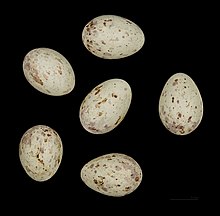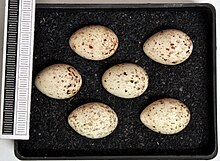Snow bunting
| Snow bunting | ||||||||||||
|---|---|---|---|---|---|---|---|---|---|---|---|---|

Male Snow Bunting ( Plectrophenax nivalis ) |
||||||||||||
| Systematics | ||||||||||||
|
||||||||||||
| Scientific name | ||||||||||||
| Plectrophenax nivalis | ||||||||||||
| ( Linnaeus , 1758) |
The Snow Bunting ( Plectrophenax nivalis ) is a bird art from the family of Sporn- and snow buntings (Calcariidae). It is a bird of the northern latitudes and prefers tundra areas as a breeding ground.
description
Snow bugs are 16.5 cm long and weigh 26–40 g, making them about the size of a house sparrow . The wingspan is 32 to 38 centimeters.
Adult males are easy to recognize by their black and white plumage. However, it takes two years for this white to fully develop in young birds. Often the back also has a brown tone. The females are more brownish, but also have a white underside. The wings of the snow bunting are relatively long, their beaks are rather short.
habitat
In Europe, snow bunting are restricted to the north. In northern Germany to France and Poland as well as in southern Sweden they are winter guests. Here they can often be found in small groups on open wasteland and lawns, and sometimes they also visit the inland . In the summer they breed in Fjell and in the tundra of Scandinavia and Scotland , mostly above the tree line. In Iceland and central Norway , they are available all year round.
singing
In the group they utter trilling calls like "tirr", "diüh" or "tsrr". You can only hear their singing in their northern breeding areas.
Way of life
The food of the snow bunting consists of finer seeds and insects .
The breeding season begins in March. However, at first only the males are at the breeding site, trying to demarcate their territories with their song. But when it starts to snow again, the animals gather again in small groups. The females arrive several weeks later. The nest lies between stones or in crevices and consists of stalks and lichen . The inner lining consists of hair and feathers. There are one or two broods per year.
The eggs, 4–6 in number, are yellowish-gray to light-bluish, but can also have a rust-brown to dark brown color. They are incubated for 12–13 days.
supporting documents
literature
- Richard Sale: A Complete Guide to Arctic Wildlife , published by Christopher Helm, London 2006, ISBN 0-7136-7039-8
Individual evidence
- ↑ Sale, p. 330
Web links
- Plectrophenax nivalis in the endangered Red List species the IUCN 2008. Posted by: BirdLife International, 2008. Accessed January 31 of 2009.
- Videos, photos and sound recordings of Plectrophenax nivalis in the Internet Bird Collection
- Feathers of the snow bunting


